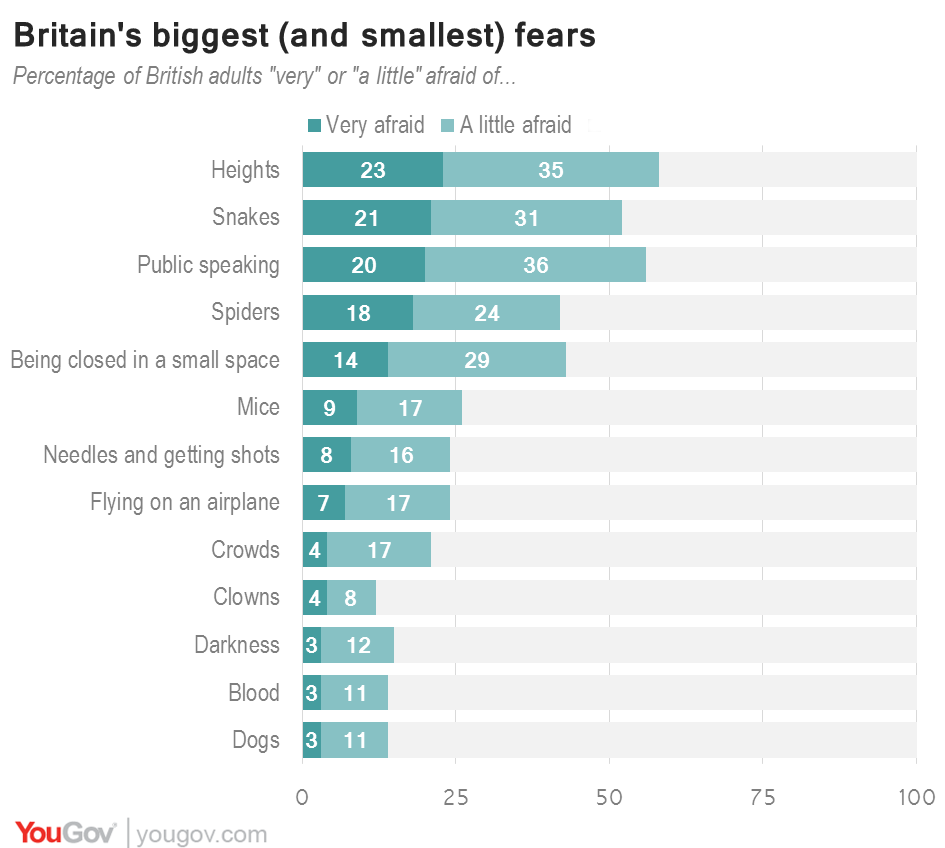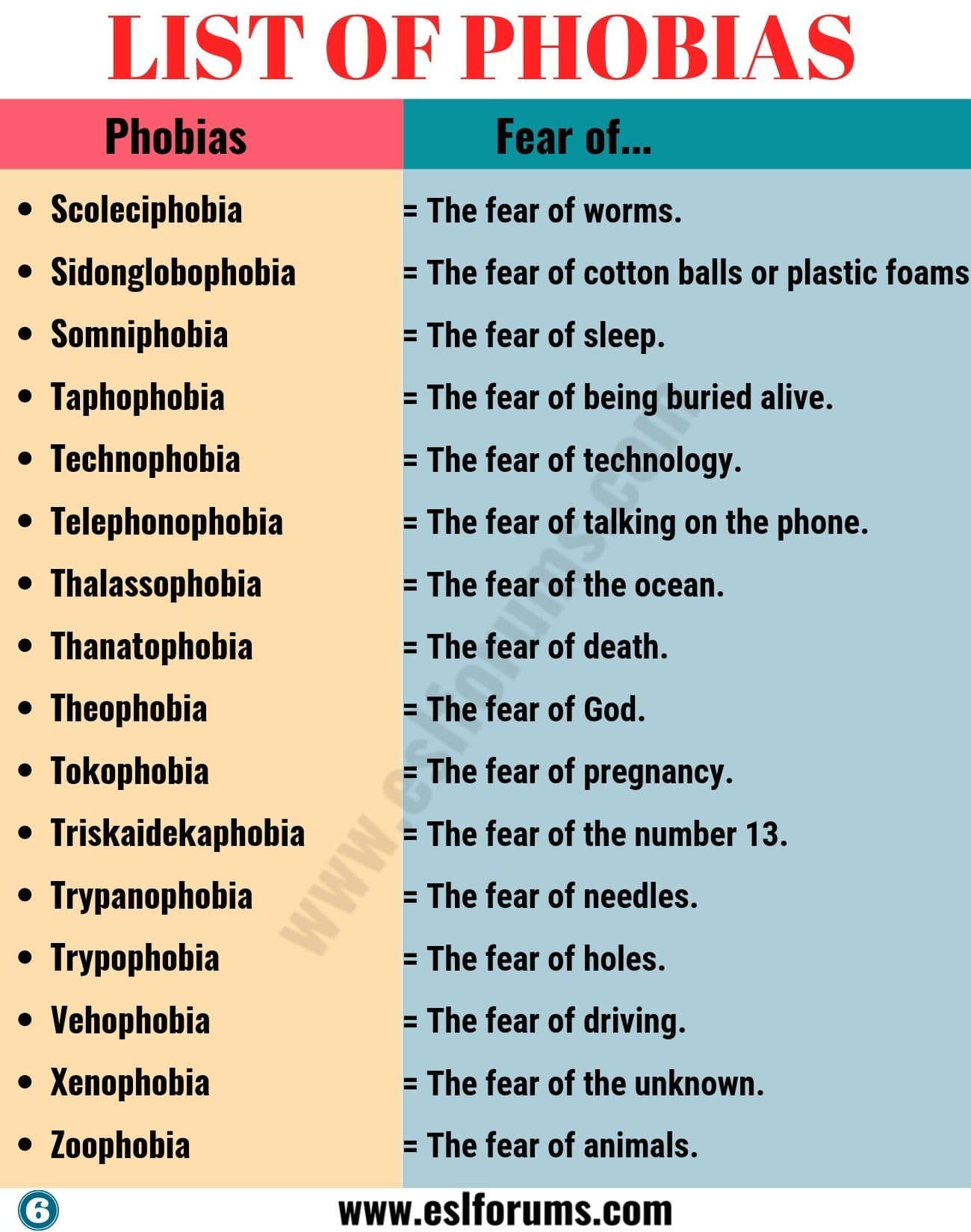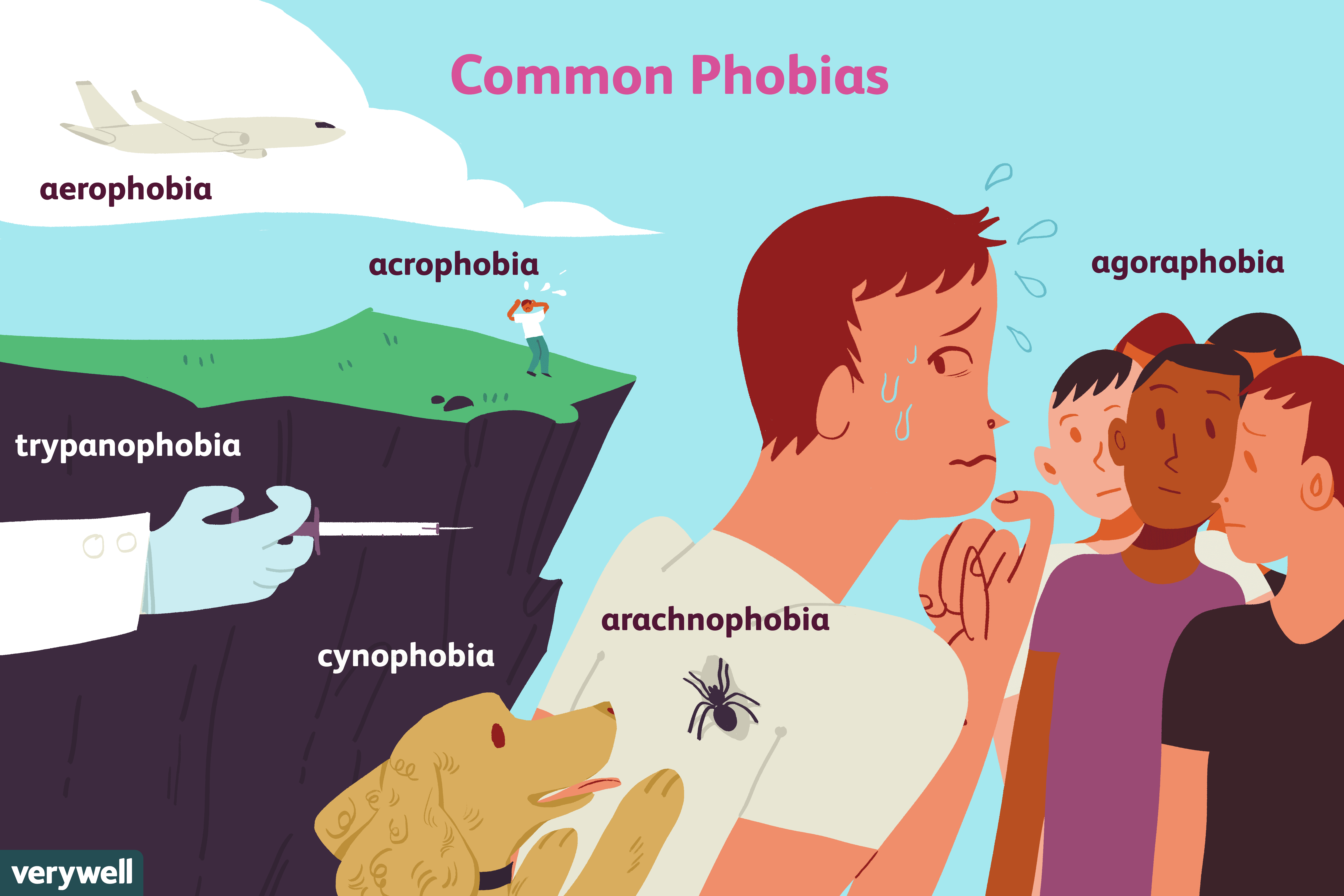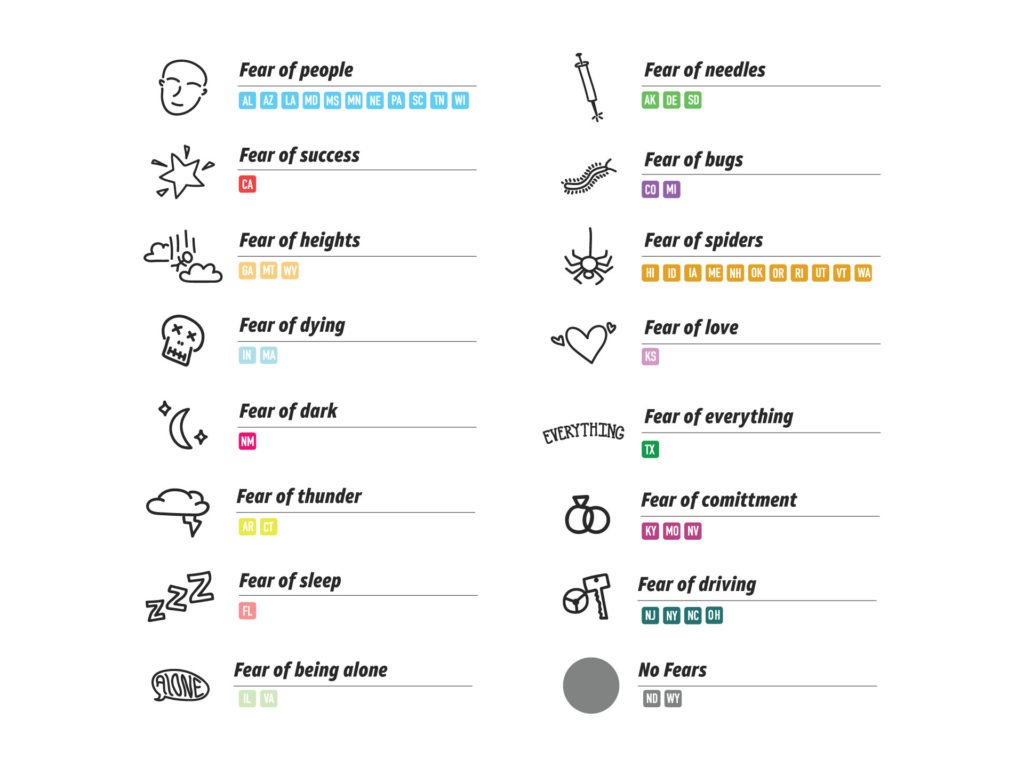How Do We Classify Phobias
Leading minds in the world of psychology created the DSM for a wide range of psychological disorders which also include Phobias.
This guide to diagnosing and explaining mental disorders classifies phobias under 5 different categories:
- Animal Phobias
- Natural Environment Phobias
- Blood-Injection-Injury Phobias
- Situational Phobias
- Other Phobias
These five categories encompass all of the phobias known to man, within each category there encompasses hundreds of phobias.
Ophidiophobia The Fear Of Snakes
The fear of snakes or Ophidiophobia is the second most common zoophobia affecting nearly 1/3rd of the adult human population. Like the phobia mentioned below, the fear of snakes also has evolutionary roots. To an extent, the fear of venomous snakes is also essential for survival. Extreme Ophidiophobia can affect ones life as one tends to avoid hiking, camping and related activities or might even become afraid of pet store snakes and other reptiles. Next up is the number one phobia of all time.
What Are The Top 10 Phobias
We all have things we fear snakes and hedgehogs are mine. Most of the time these fears do not impact on our daily lives but if they do then it may be time for some for a short course in behaviour therapy. The top ten phobias include:
1. Arachnophobia: The fear of spiders. This phobia tends to affect women more than men.
2. Ophidiophobia: The fear of snakes.
3. Acrophobia: The fear of heights.
4. Agoraphobia: The fear of situations in which escape is difficult. This may include crowded areas, open spaces, or situations that are likely to trigger a panic attack. People will begin avoiding these trigger events, sometimes to the point that they cease leaving their home. Approximately one third of people with panic disorder develop agoraphobia.
5. Cynophobia: The fear of dogs. This phobia is often associated with specific personal experiences, such as being bitten by a dog during childhood.
6. Astraphobia: The fear of thunder and lightning.
7. Trypanophobia: The fear of injections. Like many phobias, this fear often goes untreated because people avoid the triggering object and situation.
8. Social Phobias: The fear of social situations. In many cases, these phobias can become so severe that people avoid events, places, and people that are likely to trigger an anxiety attack.
9. Pteromerhanophobia: The fear of flying. Often treated using exposure therapy, in which the client is gradually and progressively introduced to flying.
Reference: psychology.about.com
What Are We Afraid Of
Illustration by Emily Roberts, Verywell
Phobias are surprisingly common, but what exactly do people fear the most? Are there any phobias that tend to be more common than others?
The following phobias are ten of the most common objects or situations that lead to marked fear and symptoms such as dizziness, nausea, and breathlessness. In some cases, these symptoms escalate into a full-blown panic attack.
Social phobia and agoraphobia are in their own category of anxiety disorders, where the remaining eight phobias are considered “specific phobias,” related to a particular object or situation.
These common phobias typically involve the environment, animals, fears of injections and blood, as well as certain other situations.
Acrophobia: Fear Of Heights

Acrophobia is an excessive fear of heights and manifests as severe anxiety. A person could have an attack just walking up stairs or climbing a ladder. Sometimes the fear is so great a person can’t move. Acrophobia can create a dangerous situation for someone who has it. An anxiety attack can make it extremely difficult to safely get down from whatever high place triggered the attack.
Treating Phobias In Baton Rouge
It is perfectly normal to experience some level of hesitation or nervousness when confronted with a new or intimidating situation. However, such instances should not produce symptoms of panic such as increased heart rate, rapid breathing, trembling, and nausea. If these types of symptoms occur as the result of a particular object or situation, you are likely suffering from a phobia. Fortunately, most of these conditions can be improved dramatically with care from a mental health professional. If you are in the Baton Rouge area and struggling with a phobia, contact Psychiatry Associates of Baton Rouge to request an appointment with one of our skilled psychiatric physicians.
Unusual And Uncommon Phobias
A phobia is a mental condition that occurs due to feelings of persistent and unreasonable fear caused by an object or situation. Although there is normally little danger in object of the phobia, the presence or anticipation of the object can cause signifiant distress, including panic attacks, fainting, and/or sweating. Some of the most unusual and uncommon phobias are included below.
What Are The Different Groups Of Phobias
What are the different groups of phobias?There are three main groups of phobias which include the following
- Specific phobia: These are the most common type of phobias and focus on a specific object. Specific or simple phobias produce intense fear of a particular object or situation that is, in fact, relatively safe. People who suffer from specific phobias are aware that their fear is irrational, but the thought of facing the object or situation often brings on a panic attack or severe anxiety. Examples may include persistent fear of dogs, insects, or snakes; driving a car; heights; tunnels or bridges; thunderstorms; and/or flying.
- Social phobia: People with a social phobia are afraid of being in the company of other people. They fear being humiliated or embarrassed in front of other people. This problem may also be related to feelings of inferiority and low self-esteem and can drive a person to drop out of school, avoid making friends, and remain unemployed.
- Agoraphobia: People with agoraphobia are afraid of being in open spaces such as markets, bank queues, or bridges. In some cases, panic attacks can become so debilitating that the person may develop agoraphobia because they fear another panic attack. In extreme cases, a person with agoraphobia may be afraid to leave their house.
Agoraphobia: Fear Of Public Places
The agora was a market and meeting place in ancient Greece. Someone with agoraphobia is afraid of being trapped in a public place or a place like a bridge or a line at the bank. The actual fear is of not being able to escape if anxiety gets too high. Agoraphobia affects twice as many women as men. If left untreated in extreme cases, it can lead to someone becoming housebound.Â
What Are The Most Common Phobias And What Are The Psychological Causes Of Them
Are you afraid of spiders, heights, or clowns? Well, youre not alone. But just what is the most common phobia?
Our fears of seemingly trivial things can seem irrational at times, but these are fears shared by millions of people. Even something as harmless as a mouse can strike fear in a grown adult.
For many phobias, we’ve got a decent idea of what causes them. For others, the jury is still out and some are yet to be recognized as official phobias.
Using data from a survey by YouGov, which had a relatively large sample of 2,088 adults, we’re going to run through the top 10 in their list, from most to least common, and explain a bit about each.
Lets begin.
1. Heights
In first place, the most common phobia is the fear of heights. Twenty-three percent of respondents said they were very afraid of heights, while 35 percent said they were a little afraid. People tended to get more fearful as they got older, too.
This is known as acrophobia, which comes from the Greek ákron meaning peak or edge. This phobia appears to stem from an inability to perceive vertical dimensions.
Research suggests that people with this phobia overestimate vertical distances, and those with the biggest miscalculation have the strongest fear of heights. Its not clear which one drives the other, however.
2. Snakes
In second place, with 21 percent of people very afraid and 31 percent a little afraid, its the humble snake.
3. Public speaking
Top 20 Most Common Phobias In The World Ranked By Most Popular To Least
Everyone is scared of something. Yes even you, so what are the most common phobias? What is your biggest fear?
We collected the 20 most popular phobias of our world, they are arranged in order and they came from a survey which more than 10,000 people around the world took part in.
Now obviously fears in different countries and regions are different, but this is to show the worlds fears as a collective, scroll to browse the list of phobias and when you find your biggest fear, please leave a comment about it so we will see the results by everyone who read this. Good luck!
The Three Kinds Of Phobia
Hundreds of different phobias have been identified, including phobophobia or fear of phobias. But when talking about phobias, which are a kind of anxiety disorder, experts divide them into three categories — agoraphobia, an intense anxiety in public places where an escape might be difficult; social phobia, a fear and avoidance of social situations; and specific phobia, an irrational fear of specific objects or situations.
Aerophobia: Afraid To Fly

Someone who has aerophobia is afraid of flying. The phobia generally develops after a person has a traumatic experience involving an airplane, such as going through extreme turbulence or witnessing another passenger have a panic attack. Even after the incident is forgotten, the fear stays and can even be triggered by watching film of a plane crash on TV. Hypnotherapy is commonly used to identify the initial trauma and to treat this phobia.
Phobophobia The Fear Of Fear
According to President Roosevelt in his inaugural speech, the only thing we need to fear is fear itself. Some people took that way too seriously. Those who suffer from this phobia experience fear in the thought of becoming anxious or overwhelmed in the general fear of something, even fearing embarrassing themselves or having an anxiety attack, triggering even more fear and anxiety. This might be one of the most anxiety-ridden phobias on this list.
Sidonglobophobia The Fear Of Cotton Balls
This might look like a laughing matter, but people with Sidonglobophobia tend to cry or experience a full-blown panic attack at the sight or image of cotton balls, making it impossible to even use a Q-tip or open their medicine bottles. It is even believed that Michael Jackson suffered from this phobia. It’s believed that this fear develops in childhood due to negative or traumatic experiences connected to cotton balls.
Of The Worlds Weirdest Phobias
If youre like most people, then its probable that youve picked up a phobia or two in your time. A fear of spiders, clowns or heights is pretty commonplace it turns out and if flying is your biggest worry, you should count yourself lucky. For some people, life is not so easy. The most banal things come equipped with the most terrifying consequences for some and making it through one day can be a truly scary ordeal. Some phobias out there are seriously weird and if you think youre scared of strange things, just wait for what we have to show you.
How Can You Manage Your Phobias
While it’s easy to dismiss other people’s phobias, in severe cases they can have an extremely negative impact on someone’s life. For example, it’s not hard to see how a fear of public speaking might harm someone’s career prospects.
A phobia can easily bring about an anxiety attack, There are many potential physical and psychological symptoms, from sweating and trouble breathing to simply not being able to control your thoughts.
If you have a phobia that’s stopping you making the most of life, our GPs are here to help you. These are just a few of the treatment options available.
What Is A Phobia
A phobia is a strong, irrational fear of something that poses little or no actual danger. It is a type of anxiety disorder. A phobia is a persistent, excessive, unrealistic fear of an object, person, animal, activity, or situation. Phobias are diagnosable mental disorders. People with phobias try to avoid what they are afraid of. If they cannot, they may experience the following
- Panic and fear
- A strong desire to get away
Common Phobias List A
Zoophobia: A Menagerie Of Fears
The most common type of specific phobia is zoophobia or fear of animals. Zoophobia is actually a generic term that encompasses a group of phobias involving specific animals. Examples include arachnophobia — fear of spiders; ophidiophobia — fear of snakes; ornithophobia — fear of birds, and apiphobia — fear of bees. Such phobias often develop in childhood and sometimes go away as the child ages. But they can persist into adulthood.
Americas Top Fears: Public Speaking Heights And Bugs

Democrats are nearly twice as likely as Republicans to have a fear of clowns. They are also significantly more likely to fear bugs, snakes and other animals, as well as blood and needles. Democrats are slightly more likely to be afraid of ghosts.
These are among the findings of the Chapman University Survey on American Fears, which examined American fears and anxieties across a variety of topics – personal safety, the government, disasters and more. Last week I reported on partisan differences in Americans’ belief in the occult, noting that Democrats were more enthusiastic believers in the paranormal than Republicans.
Perhaps due partly to their belief in the unbelievable, Democrats tend to be more phobia-stricken than Republicans, according to the survey. Chapman researchers asked about a dozen different phobias, ranging across everything from public speaking to zombies. On a number of questions, Democrats were more fearful than Republicans. But Republicans weren’t significantly more fearful on any of them.
Overall, fear of public speaking is America’s biggest phobia – 25.3 percent say they fear speaking in front of a crowd. Clowns are officially scarier than ghosts , but zombies are scarier than both .
But it also helpfully shows us that Democrats are beset by their own anxieties. Whether it’s more irrational to fear clowns or “job-stealing immigrants” is an entirely different question.
What are you afraid of, Wonkblog readers?
How Do You Treat A Phobia
Phobias can be hard to treat but not impossible. The best way to overcome a phobia is to present it to the afflicted in a safe environment. This would need to be done repeatedly and would show the person that there is no reason to be scared of their phobia. One of the best ways to replace bad memories is to drown them out with more pleasant ones.
Somniphobia The Fear Of Sleep
Sleep is a basic need for survival. The brain needs to shut down for a few hours so it can run smoothly every day, for work, social interactions, and hobbies. However, there are people in the world that suffer from anxiety related to sleep, to which we call Somniphobia. It’s a fear greatly related to the phobia of the unknown, the anxiety of wondering what could happen after one falls asleep, whether that be experiencing nightmares or being unable to wake up at all.
Astraphobia The Fear Of Thunder And Lightning
Storms are a common occurrence in many parts of the world, and to an Astraphobic individual, they can be downright debilitating. The majority of sufferers of Astraphobia are children, although the phobia can persist into adulthood as well. Even the most ferocious and wild animals have an extreme fear of thunder and lightning, and hiding is the natural psychological defense. Astraphobia, also called Brontophobia, is known to affect nearly 2% of Americans. Thankfully, it is a highly treatable phobia with many treatment options.
Triskaidekaphobia The Fear Of The Number 13
You’ve probably heard of this one before, it’s greatly related to superstitions that take us back thousands of years ago. It’s a number always associated with something negative and evil, and people who suffer from phobia take this too far. They might even refuse to leave their home on the 13th of each month or avoid anything that has to do with this number. Friday The 13th is probably not the best horror movie to watch this Halloween.
What Are The Biological Responses To Fear
Fear triggers a response in the amygdala in the brain, which then transmits to the rest of your body and signals either a fight, flight, or freeze response. It causes an insurgence of stress hormones and heightened responses by the sympathetic nervous symptom.
There is research that shows that our biological make-up may not only lead to responses to a phobia but can be an important factor in causing them. Studies show that genetic predispositions can cause some of us to be more susceptible to stressful and traumatic triggers. Varying levels of serotonin can also cause a change in moods and behaviors, as well as cause phobias to develop. Fear mechanisms can be innate, non-experiential or experience-based.
However, there needs to be more, extensive research done in this area to come up with conclusive results. Biological models tend to be reductive, and it can be difficult to generalize findings to a larger population because the sample is not always representative.
Lets take a look at some of the most common phobias that exist.
The 10 Most Common Phobias In The World
Phobias are fears that keep some peoples lives captive. There are thousands of phobias around the world associated with fear of very different things. Phobias are not really fears to be taken lightly. One cause of most phobias is thought to be related to a past experience. However, it may not be possible to understand why some phobias exist in some people. Many different treatment methods to get rid of phobias
Phobias are the fears that capture the lives of some people. There are thousands of phobias around the world associated with fear of very different things. Phobias are not really fears to be taken lightly. One cause of most phobias is thought to be related to a past experience. However, it may not be possible to understand why some phobias exist in some people. There are many different treatment methods available to get rid of phobias. There are also methods whose success varies according to the person. In fact, the number of people who apply to people who are not at all competent to get rid of phobias is not very few.
If you have a phobia, you need experts to overcome it. So what are the most common of these thousands of different types of phobias? We dont know if you have a phobia, but these 10 phobias are very common around the world and have affected millions of people.
10. Cardiophobia
9.
8. Astrophobia
Astrophobia is the extreme fear of lightning and thunder.
7.
6. Acrophobia
Acrophobia, which is a very severe fear of heights, is a dangerous phobia.
1.
Omphalophobia The Fear Of Belly Buttons
Could you imagine being scared of your own belly button? For people suffering from omphalophobia, this is a reality. They don’t like touching their navel or even looking at it, which can cause them to feel disgusted and terrified. Singer Jenny Frost is one of the most famous celebrities with this phobia and she always warns people to never touch her belly button.
Globophobia The Fear Of Balloons

When you think of some of the silliest phobias in the world, we’re sure the fear of balloons, or globophobia, is high up on the list. Turns out, even Oprah Winfrey is afraid of balloons, and if that isn’t enough to make you feel better about your phobia, we don’t know what is. People suffering from this phobia feel a severe fear at the thought, sight, touch or even smell of balloons. The sound of it popping is enough to set a sufferer running for life.
Anatidaephobia The Fear Of Ducks
You’ve probably seen it in movies or TV where someone is deadly afraid of ducks and they’re then chased by one. Well, there is a name for that: Anatidaephobia. The phobia consists of the person suffering feelings as though somewhere in the world, a duck or a goose is watching them. Phobics will feel, no matter what they are doing or where they are, a constant presence of a duck or goose.
Of The Rarest Phobias In The World
| Stuff
Everyone is afraid of something, but when the fear becomes too intense and disruptive, a phobia can develop. While everyone has heard of common phobias like arachnophobia, claustrophobia, and aerophobia , there are numerous phobias that most people have never heard of. This list includes some of the rarest phobias in the world.
In general, phobias can be divided into three categories: specific phobias, social phobia, and agoraphobia. All phobias are a type of anxiety disorder and share symptoms commonly associated with anxiety.
Since there are not a lot of statistics regarding how many people might suffer from a certain phobia, this list was arranged in alphabetical order.
Arachnophobia The Fear Of Spiders
| Photo: The Mirror |
Nearly 30.5% of Arachnophobia sufferers are living in the United States alone. It is one of the most common animal phobias around the world. The cause of the phobia is often evolutionary meaning that some species of spiders are deadly and it is a natural human response to survive. Arachnophobes however tend to go to extreme lengths to ensure that their surroundings are free from spiders, often causing themselves a great deal of embarrassment, which is something most phobics try hard to avoid.
Trypophobia The Fear Of Holes
| Photo: The Conversation |
Biological revulsion and culturally learned fears are the primary causes of Trypophobia, which is the extreme and irrational fear of holes. While this fear might seem irrational to normal people, the mere sight or thought of holes can set off a panic attack in the Trypophobe. As a result, the individual avoids objects such as coral, sponges, skin, meat, dried honeycombs and pretty much everything that has holes on it. Holes seem disgusting and gross to the sufferer and s/he goes to all lengths to avoid it.
What Are The Treatment Options For Phobias
Phobias are treatable and people who have them are nearly always aware of their disorder. This helps diagnosis a great deal. Phobias are treated with a combination of therapy and medications, which may include the following
- Behavioral therapy: Behavioral therapy is an umbrella term for the types of therapy that are used to treat mental health disorders. This form of therapy seeks to identify and help change potentially self-destructive or unhealthy behaviors. It functions on the idea that all behaviors are learned and that unhealthy behaviors can be changed. The focus of treatment is often on current problems and how to change them.
- Cognitive behavioral therapy : The doctor, therapist or counselor helps the person with a phobia learn different ways of understanding and reacting to the source of their phobia. This can make coping easier. Most importantly, CBT can teach a person experiencing a phobia to control their own feelings and thoughts.
- Medications such as beta blockers, antidepressants and tranquilizers may help treat a phobia
- Beta blockers: These can help reduce the physical signs of anxiety that can accompany a phobia.
- Antidepressants: Serotonin reuptake inhibitors are commonly prescribed for people with phobias. They affect serotonin levels in the brain and this can result in better moods.
- Tranquilizers: Benzodiazepines are an example of a tranquilizer that might be prescribed for a phobia. These may help reduce anxiety symptoms.